Week 5: Jan 31 – Feb 6, 2005
|
|
| THIS WEEK | WINTER TOTAL | YEAR TOTAL | SITE TOTAL | |
|---|---|---|---|---|
| # birds (and species) banded | 12 (5) | 206 (9) | 12 (5) | 930 (48) |
| # birds (and species) repeat | 8 (1) | 83 (9) | 8 (1) | 186 (17) |
| # birds (and species) return | — | — | — | 2 (1) |
| # species observed | 17 | 30 | 19 | 136 |
| # net hours | 7.0 | 59.0 | 7.0 | 981.5 |
| # birds banded / net hour | 171.4 | 347.5 | 171.4 | 94.7 |
Note: table does not include nocturnal banding (owls).
Bander-in-charge: Marcel Gahbauer Assistants: Christina Donehower, Marie-Anne Hudson
Notes: Most of January was very cold – too much so for us to attempt any banding. Temperatures have warmed up nicely this week, and finally on Sunday both weather and time availability coincided to allow us our first banding opportunity of 2005. Not surprisingly, the first bird caught was a Black-capped Chickadee. However, we did also catch half a dozen unbanded chickadees, suggesting that the flock has changed somewhat in composition since our last banding efforts before Christmas, when it seemed that the vast majority of the local birds had been banded. Rounding out the birds banded today were small numbers of American Goldfinch, Slate-coloured Junco, American Tree Sparrow, and Blue Jay. The highlight of the day was a brief glimpse of a Pine Grosbeak in the trees behind the feeders – our 136th species for the site. Also of note, a Brown Creeper in the woods north of the cabin, a Deer Mouse under the feeders, and the distinct tooth-marks on our birdseed bin of a mystery rodent.
Week 6: Feb 7 – Feb 13, 2005
|
|
| THIS WEEK | WINTER TOTAL | YEAR TOTAL | SITE TOTAL | |
|---|---|---|---|---|
| # birds (and species) banded | — | 206 (10) | 12 (5) | 930 (48) |
| # birds (and species) repeat | 1 (1) | 84 (9) | 9 (1) | 187 (17) |
| # birds (and species) return | — | — | — | 2 (1) |
| # species observed | 14 | 30 | 19 | 136 |
| # net hours | 1.0 | 60.0 | 8.0 | 982.5 |
| # birds banded / net hour | — | 341.7 | 150.0 | 94.7 |
Note: table does not include nocturnal banding (owls).
Bander-in-charge: Marcel Gahbauer
Notes: Days scheduled for banding this week were generally too cold or windy for the nets to be opened. A single net was put up for a short while on Sunday morning while tending to other station duties, and a lone Black-capped Chickadee came in for a visit as a result. It was one of the half dozen which had been banded a week ago. For over an hour, a Northern Shrike sang almost without pause from a treetop near the banding cabin. Also of note, for the second consecutive week there was a single Pine Grosbeak in the woodlot just south of the feeders. The mystery rodent mentioned last week is a mystery no more – upon entering the cabin Sunday morning, I saw a Red Squirrel scurrying up a beam and disappearing through a small hole in the roof. It has continued its chewing rampage inside, and now that we know its point of entry, will have to try to block it to prevent further damage.
Week 7: Feb 14 – Feb 20, 2005
|
|
| THIS WEEK | WINTER TOTAL | YEAR TOTAL | SITE TOTAL | |
|---|---|---|---|---|
| # birds (and species) banded | 7 (4) | 213 (11) | 19 (6) | 937 (48) |
| # birds (and species) repeat | 2 (1) | 86 (9) | 11 (1) | 189 (17) |
| # birds (and species) return | 1 (1) | 1 (1) | 1 (1) | 3 (2) |
| # species observed | 11 | 31 | 20 | 137 |
| # net hours | 5.0 | 65.0 | 13.0 | 987.5 |
| # birds banded / net hour | 140.0 | 326.2 | 146.2 | 94.8 |
Note: table does not include nocturnal banding (owls).
Bander-in-charge: Marcel Gahbauer Banding assistants: Jean Brunet, Gay Gruner, Barbara Macduff, Betsy McFarlane
Notes: It was largely another cold week, and again we were able to go out only once, on Monday morning. Even then, it was too cold to open the nets right away, so we stayed inside and warmed up around the fireplace for a while before getting started. During the brief period that we ended up having the nets open, we caught 10 birds, mostly Black-capped Chickadees. Among the birds banded were also a Blue Jay, a Downy Woodpecker, and an American Tree Sparrow. One of the chickadees had not been observed since last October, qualifying it as a return, rather than a repeat. The local Northern Shrike was observed again, though it was silent this time. The highlight of the day was a flock of 23 Bohemian Waxwings flying over the nets, our 137th species for MBO.
Week 8: Feb 21 – Feb 27, 2005
|
|
| THIS WEEK | WINTER TOTAL | YEAR TOTAL | SITE TOTAL | |
|---|---|---|---|---|
| # birds (and species) banded | 7 (6) | 220 (13) | 26 (8) | 944 (48) |
| # birds (and species) repeat | 10 (2) | 96 (9) | 21 (2) | 199 (17) |
| # birds (and species) return | 1 (1) | 2 (2) | 2 (2) | 4 (3) |
| # species observed | 13 | 31 | 20 | 137 |
| # net hours | 10.0 | 75.0 | 23.0 | 997.5 |
| # birds banded / net hour | 70.0 | 292.0 | 113.0 | 94.5 |
Note: table does not include nocturnal banding (owls).
Bander-in-charge: Marcel Gahbauer Banding assistants: Mélisa Brunet, Isabel Julian, Noemie Laplante, Barbara Macduff, Arnaud Tarroux
Notes: Banding this week took place on Tuesday, as the final flurries from the latest day-long snowfall were tapering off. Things started off slowly with just a trickle of Black-capped Chickadees. Midway through the session, we caught an interesting Hairy Woodpecker, with a few orange feathers in the rear of the crown. Most likely it was an old female with a diet that caused the feathers to appear orange rather than red. We thought that would be the highlight of the day, but on our final net round it was surpassed by a second-year Northern Shrike, presumably the one which has been seen (and heard) in the area regularly this winter. As is normal for shrikes, this one knew all too well how to use its beak, and the two of us who handled it each lost some flesh and blood in the process! We ended up with a relatively small number of birds banded today, but a nice variety, also including a House Finch, House Sparrow, and American Tree Sparrow; our lone return was a Slate-coloured Junco banded here in October.
Week 9: Feb 28 – Mar 6, 2005
|
|
| THIS WEEK | WINTER TOTAL | YEAR TOTAL | SITE TOTAL | |
|---|---|---|---|---|
| # birds (and species) banded | 6 (4) | 226 (13) | 32 (8) | 95- (48) |
| # birds (and species) repeat | 2 (1) | 98 (9) | 23 (2) | 201 (17) |
| # birds (and species) return | 2 (2) | 4 (3) | 4 (3) | 6 (4) |
| # species observed | 15 | 32 | 22 | 138 |
| # net hours | 8.0 | 83.0 | 31.0 | 1005.5 |
| # birds banded / net hour | 75.0 | 271.1 | 103.2 | 94.4 |
Note: table does not include nocturnal banding (owls).
Bander-in-charge: Marcel Gahbauer Banding assistants: Shawn Craik, Jean Demers, Christina Donehower, Sarah Fraser, Marie-Anne Hudson, Julia Mlynarek, Clémence Soulard
Notes: Without question, this week’s highlight was the sighting on Saturday March 5 of MBO’s first Great Gray Owl. It was perched fairly low down in one of the poplars along the “B” ridge, so well camouflaged that several observers walking down the path didn’t discover the owl until almost below it. The owl showed no great interest in its human audience, and continued scanning the area for prey. Over the course of the morning it made a couple of short flights around the rear duck ponds, but most of the time could be seen in the distance as we went in and out of the banding cabin. The owl more than compensated for what was a quiet morning at the nets, largely the consequence of a gusty southwest wind that made the nets particularly conspicuous. All the same, we did band yet another Blue Jay, as well as a new American Tree Sparrow, and a couple each of Black-capped Chickadee and American Goldfinch, the latter already showing visibly more yellow and black in their plumage compared to earlier in the winter. Also another two returns today, a Black-capped Chickadee last recorded in October 2004, and an American Tree Sparrow not observed since the beginning of last December.
Week 10: Mar 7 – Mar 13, 2005
|
|
| THIS WEEK | WINTER TOTAL | YEAR TOTAL | SITE TOTAL | |
|---|---|---|---|---|
| # birds (and species) banded | — | 226 (13) | 32 (8) | 950 (48) |
| # birds (and species) repeat | — | 98 (9) | 23 (2) | 201 (17) |
| # birds (and species) return | — | 4 (3) | 4 (3) | 6 (4) |
| # species observed | 12 | 32 | 22 | 138 |
| # net hours | — | 83.0 | 31.0 | 1005.5 |
| # birds banded / net hour | — | 271.1 | 103.2 | 94.4 |
Note: table does not include nocturnal banding (owls).
Bander-in-charge: Marcel Gahbauer Banding assistants: Shawn Craik
Notes: An unusually cold, windy, and snowy second week of March kept us from banding. However, most of the regular species were seen during trips to fill the feeders. Of interest, one of the American Tree Sparrows was observed perching on the nyjer seed feeder, rather than just foraging on the snow below as usual. We also learned this week from a reliable observer that the local Great Gray Owl has in fact been seen as far back as the end of January, sometimes even perched on top of our net poles, or out in the open on the martin condominium!
Week 11: Mar 14 – Mar 20, 2005
|
|
| THIS WEEK | WINTER TOTAL | YEAR TOTAL | SITE TOTAL | |
|---|---|---|---|---|
| # birds (and species) banded | 14 (6) | 240 (14) | 46 (10) | 964 (49) |
| # birds (and species) repeat | 9 (2) | 107 (9) | 32 (2) | 210 (17) |
| # birds (and species) return | 5 (1) | 9 (3) | 9 (3) | 11 (4) |
| # species observed | 20 | 36 | 26 | 138 |
| # net hours | 20.0 | 103.0 | 51.0 | 1025.5 |
| # birds banded / net hour | 70.0 | 232.0 | 90.2 | 93.9 |
Note: table does not include nocturnal banding (owls).
Bander-in-charge: Marcel Gahbauer Banding assistants: Eric Boodman, Averill Craig, Shawn Craik, Christina Donehower, Gay Gruner, Marie-Anne Hudson, Noemie Laplante, Betsy McFarlane, Arnaud Tarroux
Notes: For the first time in a long while, we were able to band twice this week. Perhaps spring is on the way after all, though MBO remains very much snow-covered. At least the American Goldfinches are an indicator of the changing seasons, with patches of vivid yellow feathers moulting in. Three new species for the year were observed this week: Ring-billed Gull, Cedar Waxwing and Red-shouldered Hawk. Still none of the more traditional signs of spring though, such as American Robin, Red-winged Blackbird, or Song Sparrow.
Banding was fairly quiet, as it appears that most of the birds in the area have figured out that the majority of our nets are quite visible. We will need to reposition the winter nets a bit next winter to improve our effectiveness. However, we had several interesting captures this week all the same, among them our first Common Redpoll and second Mourning Dove. Also of note, a Black-capped Chickadee last seen on October Such records are always of interest, but especially in this case since this bird has only one leg! Evidently it has been able to survive a long winter despite that handicap, which is an impressive accomplishment.
Week 12: Mar 21 – Mar 27, 2005
|
|
| THIS WEEK | WINTER TOTAL | YEAR TOTAL | SITE TOTAL | |
|---|---|---|---|---|
| # birds (and species) banded | 13 (4) | 256 (14) | 59 (10) | 980 (49) |
| # birds (and species) repeat | 2 (1) | 109 (9) | 34 (2) | 212 (17) |
| # birds (and species) return | 1 (1) | 10 (3) | 10 (3) | 12 (4) |
| # species observed | 14 | 36 | 26 | 138 |
| # net hours | 7.0 | 110.0 | 58.0 | 1032.5 |
| # birds banded / net hour | 185.7 | 231.8 | 101.7 | 94.8 |
Note: table does not include nocturnal banding (owls).
Bander-in-charge: Marcel Gahbauer Banding assistants: Tony Bezina, Christina Donehower, Marie-Anne Hudson, Noemie Laplante, Meghan Larivee, Catherine Lessard, Michael Mayer, Julia Mlynarek, Michelle St. Martin
Notes: With the expectation of a busier spring season soon to come, we’re keeping banding visits fairly limited toward the end of the winter season. On Monday morning, a group of volunteers began the process of reinstalling the nesting boxes around MBO, for bluebirds, swallows, chickadees, wrens, and others. Banding took place once this week, on Friday morning.
As noted last week, the American Goldfinches are rapidly moulting into their brighter summer colours. Today one male already was almost entirely yellow on the upper breast, and the individual in the photo of the week was also looking very different from when it was originally banded in early December. Despite windy conditions today, we caught 13 unbanded birds, the largest number we’ve had in a while. Among them were 9 goldfinches, including the first females we’ve banded this year (another subtle hint that the spring migration is underway even if the traditional harbingers of spring are slow in returning).
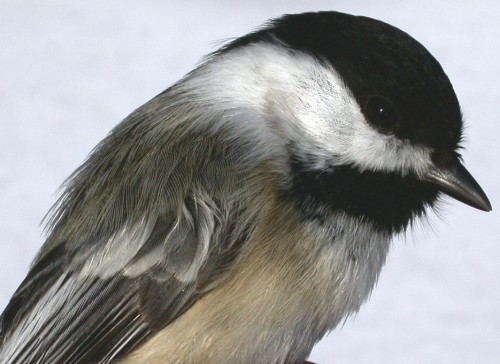 February 6, 2005: This second-year Black-capped Chickadee became our first bird captured in 2005. It was banded at MBO on September 23, 200(Photo by Marcel Gahbauer)
February 6, 2005: This second-year Black-capped Chickadee became our first bird captured in 2005. It was banded at MBO on September 23, 200(Photo by Marcel Gahbauer)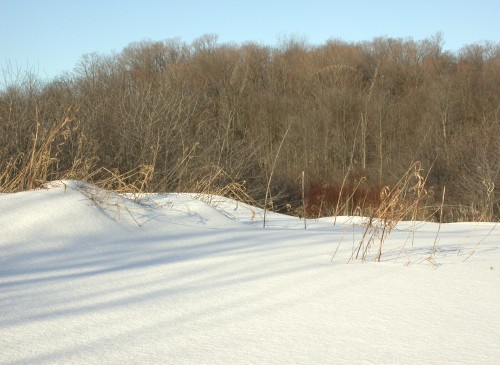 February 13, 2005: Fresh snow over the past week, combined with strong winds, resulted in drifts up to one metre deep in places. However, this didn’t deter the local Northern Shrike (actually present in this photo as a small white dot high in a tree in front of the forest) from singing at length. (Photo by Marcel Gahbauer)
February 13, 2005: Fresh snow over the past week, combined with strong winds, resulted in drifts up to one metre deep in places. However, this didn’t deter the local Northern Shrike (actually present in this photo as a small white dot high in a tree in front of the forest) from singing at length. (Photo by Marcel Gahbauer)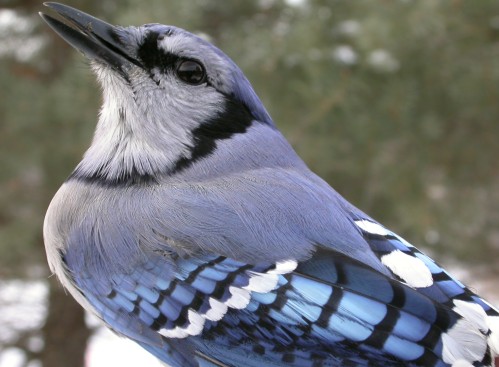 February 14, 2005: This Blue Jay caught today was the tenth one banded since last October. This individual was recognizable as an after-second-year bird by the barring on the bright blue alula feathers, visible in this photo (Photo by Marcel Gahbauer)
February 14, 2005: This Blue Jay caught today was the tenth one banded since last October. This individual was recognizable as an after-second-year bird by the barring on the bright blue alula feathers, visible in this photo (Photo by Marcel Gahbauer)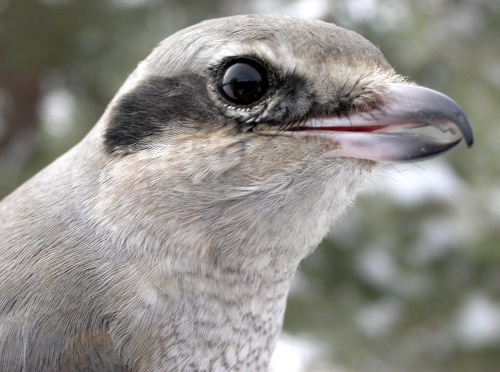 February 22, 2005: This Northern Shrike was only the second of its kind banded at MBO. Note the sharp hooked beak, and the notches on the upper mandible. The brownish tone to the plumage indicates it is a second-year bird; this was further confirmed by the distinct molt limits on the wings. Another two photos of this individual are posted in the
February 22, 2005: This Northern Shrike was only the second of its kind banded at MBO. Note the sharp hooked beak, and the notches on the upper mandible. The brownish tone to the plumage indicates it is a second-year bird; this was further confirmed by the distinct molt limits on the wings. Another two photos of this individual are posted in the 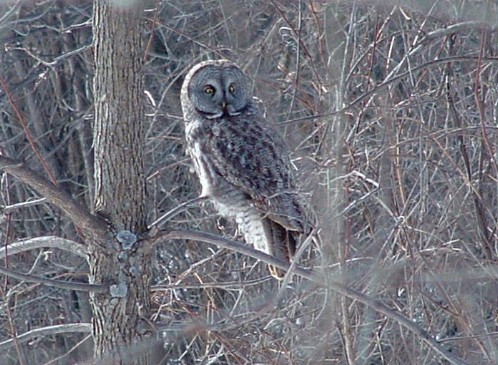 March 5, 2005: After a winter of Great Gray Owls being seen in record numbers around Montreal, this individual seen today finally marked the first one observed at MBO. Perched near the path along the B net line, it was nearly missed at first. Though sex is difficult to determine visually in Great Gray Owls, this individual seemed to many observers to be particularly small, and is likely a male. It stayed in view from the banding station throughout the morning. (Photo by Shawn Craik)
March 5, 2005: After a winter of Great Gray Owls being seen in record numbers around Montreal, this individual seen today finally marked the first one observed at MBO. Perched near the path along the B net line, it was nearly missed at first. Though sex is difficult to determine visually in Great Gray Owls, this individual seemed to many observers to be particularly small, and is likely a male. It stayed in view from the banding station throughout the morning. (Photo by Shawn Craik)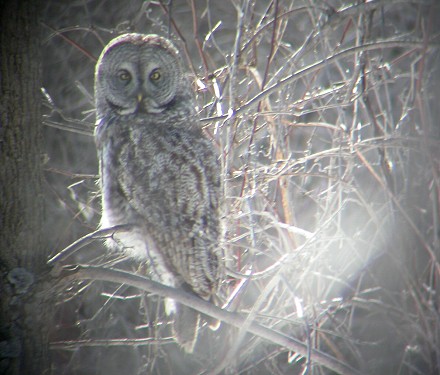 Another view of the local Great Gray Owl. (Photo by Marcel Gahbauer)
Another view of the local Great Gray Owl. (Photo by Marcel Gahbauer)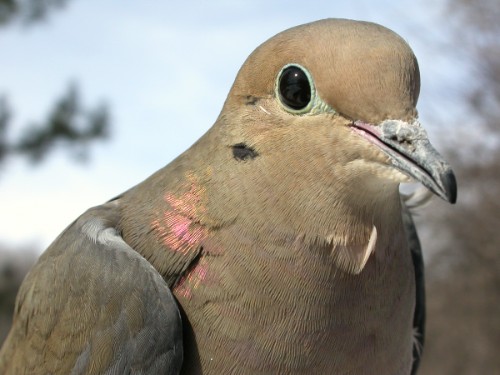 This Mourning Dove was only the second one banded at MBO. While the bluish tinge to the crown wasn’t particularly strong, the distinct rose colouration on the throat was enough to lead us to believe it is a male. (Photo by Marcel Gahbauer)
This Mourning Dove was only the second one banded at MBO. While the bluish tinge to the crown wasn’t particularly strong, the distinct rose colouration on the throat was enough to lead us to believe it is a male. (Photo by Marcel Gahbauer)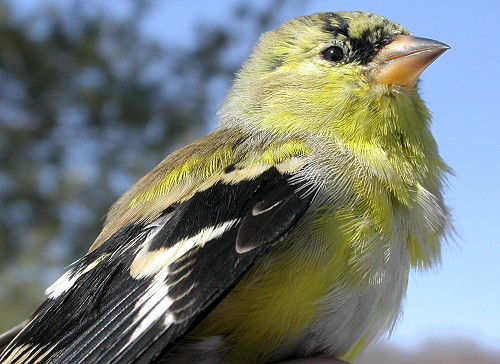 Since the expected early spring migrants (American Robin, Red-winged Blackbird, Song Sparrow, etc.) have yet to return to MBO, it’s up to the American Goldfinches to remind us the seasons are changing. The scattered patches of black on the forehead and bright yellow on the breast and throat are new feathers, likely grown within the last couple of weeks. (Photo by Marcel Gahbauer)
Since the expected early spring migrants (American Robin, Red-winged Blackbird, Song Sparrow, etc.) have yet to return to MBO, it’s up to the American Goldfinches to remind us the seasons are changing. The scattered patches of black on the forehead and bright yellow on the breast and throat are new feathers, likely grown within the last couple of weeks. (Photo by Marcel Gahbauer)